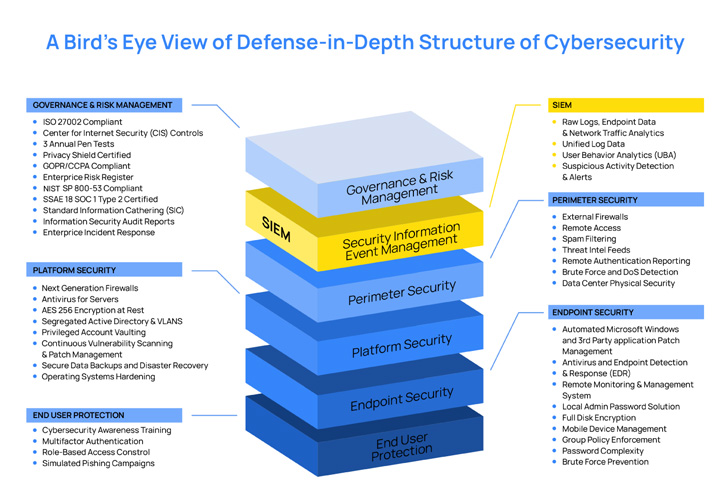The increased use of information technology in our everyday life and business has led to cyber-attacks becoming more sophisticated and large-scale. For organizations to thrive in this era of technology, they must develop robust security strategies to detect and mitigate attacks. Defense in depth is a strategy in which companies use multiple layers of security measures to safeguard assets. A well-implemented defense in depth can help organizations prevent and mitigate ongoing attacks.
Defense in depth uses various cutting-edge security tools to safeguard a business’s endpoints, data, applications, and networks. The objective is to prevent cyber threats, but a robust defense-in-depth approach also thwarts ongoing attacks and prevents further damage.
How organizations can implement defense in depth
 |
| The image above shows the various layers of security that organizations must implement. Below we describe ideas that companies should consider for each layer. |
Governance and risk management
Governance and risk management in cybersecurity revolves around three major elements; governance, risk, and compliance (GRC). The overarching purpose of GRC is to ensure that every member of an organization works together to achieve set targets. They must do this while adhering to legal and ethical guidelines, processes, and compliance standards. Such standards include NIST, PCI-DSS, HIPAA, and GDPR. Establishments must identify the standards that apply to them and use tools to automate and simplify the compliance process. These tools should be able to detect violations and provide reports and easy-to-follow documentation to resolve the violations.
Platform security
There are many ways organizations can ensure the security of the devices in their enterprise network. Two essential methods are vulnerability management and operating system hardening. Vulnerability management adds a layer of protection that ensures that companies address weaknesses in software before attackers can exploit them. On the other hand, OS hardening ensures that security teams implement additional measures to protect the integrity of data and configurations used in an operating system. They can do this by defining and enforcing policies for endpoints in their network. Other elements to ensure platform security are firewalls and implementing appropriate network segmentation.
SIEM
A security information and event management (SIEM) solution is essential to an organization’s security strategy. A SIEM aggregates and correlates logs from different sources and generates alerts based on detection rules. It also provides a central management portal for triaging and investigating incidents, and being able to collect and normalize logs from different tools and systems is one of the essential features of a good SIEM.
Perimeter security (threat intelligence)
Successful implementation of defense in depth is not focused only on the organization’s internal infrastructure but also on threat actor activities. Institutions must have a way of gathering and analyzing threat intelligence and using the data to provide security for their assets. Security teams must also use firewalls and network segmentation to protect critical infrastructure.
Endpoint security
The endpoints in an organization are critical to its operations, especially in the 21st century. Endpoint security is vital because attackers usually seek to compromise data stored on endpoints. Endpoint security has evolved over the years from anti-virus solutions to full-blown antimalware solutions, and now we are in the era of extended detection and response (XDR) solutions. XDRs go beyond the limitations of traditional antimalware solutions by correlating alerts from various sources to provide more accurate detections. They also leverage SIEM and SOAR (Security Orchestration, Automation, and Response) functionalities to detect threats in multiple endpoints and respond uniformly and effectively to any compromised endpoints.
Wazuh, the free and open source solution
Wazuh is a free, open source security platform that offers unified SIEM and XDR protection. It protects workloads across on-premises, virtualized, containerized, and cloud-based environments. Wazuh provides support to security operations with easy integration to threat intelligence feeds.
In implementing defense in depth, no single tool can cover all layers of security. However, Wazuh offers many features that organizations can use to strengthen their security infrastructure. For GRC, Wazuh provides dedicated dashboards that monitor and investigate events triggered by PCI-DSS, HIPAA, and GDPR violations. The solution also has a vulnerability detector module with out-of-the-box integration with vulnerability feeds, which scans operating systems and applications for known vulnerabilities.
Wazuh also provides a Security Configuration Assessment (SCA) module that enables users to create policies that the Wazuh server applies to every endpoint in their environment. Companies can use vulnerability detector and SCA modules to strengthen the security of the operating systems and applications deployed on their endpoints.
As an XDR, Wazuh correlates security data from several sources to detect threats in an organization’s environment. Also, it can actively mitigate threats by using its active response capability.
Wazuh is one of the fastest-growing open source security solutions, with over 10 million downloads per year. Wazuh also provides communities where users can engage Wazuh developers, share experiences, and ask questions related to the platform. Check out this documentation on how to get started with Wazuh.
